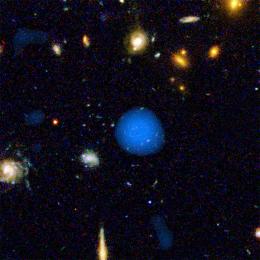Event horizon - the boundary of the black hole
One of the most shocking predictions that Einstein's gravitational theory is given is the existence of black holes. Although Eistein himself had doubts about the realities of black holes, today the scientific community has confirmed that black holes are at the center of most galaxies, and they are inevitable consequences of death. go of giant stars.
Each black hole is only one point in size, but the more mysterious feature is that it has an 'event horizon', a limited-sized virtual boundary that surrounds a black hole, where any material is (except information) will fall permanently from the universe. For humanity today, the existence and nature of event horizons is far more mysterious than the black holes themselves.
Many theories surrounding Eistein's gravity theory have been posed with various assumptions about the nature of the event horizon, even in some cases, that the event horizon is never exist. Because black holes seem to be very popular in the universe, astronomers are keen to find out the boundary around them.Their findings may also help re-test, or complement Eistein's theory, and will be a clue to understanding the nature of particles and physical forces through the extreme black hole environment.
 The X-ray image combines optics to some of the most faint galaxies that humans have ever known, and the bright rays of X-rays (green) emanating from the heated material in the nearby black hole environment. (Photo: NASA, Hubble Space Telescope, and Chandra X-ray Observatory)
The X-ray image combines optics to some of the most faint galaxies that humans have ever known, and the bright rays of X-rays (green) emanating from the heated material in the nearby black hole environment. (Photo: NASA, Hubble Space Telescope, and Chandra X-ray Observatory)
Observing the event horizon is extremely difficult because they are relatively small - the black hole in the center of our Milky Way has an estimated diameter of less than 40 astronomical units - and glows dimly because of the light. going across the border is kept. However, the accumulation of matter on plates or other structures near the event horizon produces radiation with every wavelength, many of which radiate out of the black hole to reach lateral view. in addition, so that scientists can explore the environment of the event horizon.
Recent observations of the Milky Way's central black hole, conducted by the CfA astronomical team with the Submillimeter Array telescope, have yielded some important results.
On the latest issue of the Astrophysical Journal, Avi Loeb and Ramesh Narayan of the CfA group and their colleagues used this result and some other new research results to perform calculations on a hypothetical event horizon period
For the first time, they showed that there is evidence to prove one of the basic predictions of relativity: the existence of the event horizon around the black hole in the center of the Milky Way, as well as the existence of event horizons around black holes in the universe in general.
- The giant black hole was first measured
- What happens when the Earth falls into a black hole?
- Discovering a black hole 40 billion times larger than the Sun.
- New conjecture about the shape of a black hole
- What scary thing will happen if you touch a black hole?
- The galaxy's giant black hole
- This 29-year-old girl is the one who helps find the world's shaken black hole
- This is the surreal image of the black hole in the universe
- Mystery of the black hole: Where people divide themselves?
- How to detect cosmic black holes
- Time to turn back inside the black hole
- Science warns super giant black holes that can
 Van Allen's belt and evidence that the Apollo 11 mission to the Moon was myth
Van Allen's belt and evidence that the Apollo 11 mission to the Moon was myth The levels of civilization in the universe (Kardashev scale)
The levels of civilization in the universe (Kardashev scale) Today Mars, the sun and the Earth are aligned
Today Mars, the sun and the Earth are aligned The Amazon owner announced a secret plan to build a space base for thousands of people
The Amazon owner announced a secret plan to build a space base for thousands of people